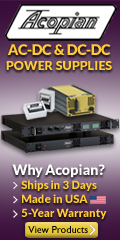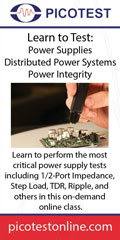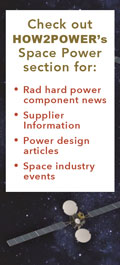 |
|
IN THIS ISSUE:
» Integrated GaN Power Stages Enable High-Performance 48-V To 12-V Power Converters
» Smart Gate Driver IC Simplifies Motor Drive Design In Battery-Powered Applications
» Designing An Open-Source Power Inverter (Part 2): Waveshape Selection
» Focus On Magnetics:
Transformer Winding Design: Bundle Layer Approximation As Rings
» Industry Event:
Free, Virtual ECCE 2021 Expo Presents Latest Tools, Instruments And Components
» Spotlight On Safety & Compliance:
A Standalone Controller Eases Compliance With USB PD Standards
» New Power Products
» Other Top Power News
From the Editor's Desk David G. Morrison
Editor, HOW2POWER TODAY

The IEEE Energy Conversion Congress & Exposition (ECCE) provides a forum for discussion of power electronics in a system-oriented context. A quick way to get a sense of this perspective for ECCE 2021, which will be held October 11-15, is by browsing the list of special sessions where you’ll see topics such as power electronics in renewables and power electronics on the grid, for example. But that type of application focus is only part of the picture, because as the other session titles suggest, there are also discussions of the closely related fields such as electric machines, which figure heavily in the conference’s overall technical program, energy storage, and even peripheral topics like cybersecurity. This system context is why they call it the energy conversion congress. Naturally, there are also special sessions on the underlying enabling technologies such as wide-bandgap devices but even these tend to be discussed in a system context such as vehicle electrification. This system context can also been seen in the tutorials. Although originally planned as a hybrid event, the conference has shifted to a fully virtual format due to ongoing Covid-related travel restrictions. For those who have not yet attended, the virtual format provides another convenient opportunity to participate. Click here to see the different options available to register. One of these options is a free registration to attend the virtual exhibition, which is previewed in this issue. The ECCE expo offers a chance not only to see the latest design tools, test instruments, and components, but also a convenient chance to ask the vendors’ experts questions on technical issues. Attend during live exhibit hours (10-11 and 10-12) for the chance to interact directly with the exhibitors or take advantage of the exhibition’s 30-day access to view vendor resources at your convenience.
|
|

|
HOW2POWER EXCLUSIVE DESIGN ARTICLES 
|
Integrated GaN Power Stages Enable High-Performance 48-V To 12-V Power Converters
by Ron Vinsant, uPI Semiconductor, Mountain View, Calif.
GaN devices are finding use in an increasing number of applications. To address these applications, uPI is introducing a family of integrated GaN power stages that combine two 100-V GaN FETs in a half-bridge configuration with a dual-channel driver and protection features. These devices simplify the development of GaN-based designs by eliminating the difficulties associated with driving enhancement-mode GaN FETs. In this article, the application of a uPI GaN power stage is demonstrated in a 48-V to 12-V, 180-W synchronous buck converter. This design example showcases the efficiency, thermal and switching performance made possible by the GaN device, while discussing elements of the design, like cooling and inductor choice, that affect converter performance. A low-cost technique for measuring the GaN device’s fast switching transitions is also described.
Read the article…
|

The nonisolated synchronous buck
converter represents the simplest
implementation of a 48-V to 12-V
converter, but the GaN power stages can
also be applied in other topologies. |

|

In a circular BLDC inverter board,
like that used in a cordless drill,
much of the PCB area is taken up by
the six MOSFETs, which does not
leave much room for the controller,
gate drive and associated functions. |
Smart Gate Driver IC Simplifies Motor Drive Design In Battery-Powered Applications
by Peter Green, Infineon Technologies, El Segundo, Calif.
The design of power-dense motor drive inverters is highly challenging, requiring many components to be placed on an often awkwardly shaped board within a confined space. At the same time, many different functions and protection schemes are necessary to produce a robust system. This article discusses how the high level of integration provided by the 6EDL7141, a smart gate driver IC for three-phase, battery-powered BLDC motor drive inverters, addresses the space limitations encountered in cordless power tools, which operate from battery packs in the 12-V to 48-V range, and similar battery-powered applications. It also explains key details of the design process when implementing motor drive inverters using this IC.
Read the article…
|

Designing An Open-Source Power Inverter (Part 2): Waveshape Selection
by Dennis Feucht, Innovatia Laboratories, Cayo, Belize
Part 1 of this series discussed the need for an open-source kilowatt-level inverter design and outlined a power architecture for such a design. Besides enabling a more serviceable, maintainable product, the proposed Volksinverter enables many improvements in the performance and functionality of what’s typically provided by low-cost power inverters marketed to consumers. Here in part 2, we delve further into system design issues, explaining how battery choices influence the selection of electrical specifications for the inverter, including its power protection features. Then we step back and review some mathematics relating to inverter-produced waveshapes, which will help us later in optimizing inverter design to meet various design goals. But first, we’ll note the similarity between inverters and another power supply function, which will help us to understand the origins of certain inverter design equations.
Read the article…
|

Battery-sourced inverters perform
the inverse function of a PFC rectifier
input of battery chargers. Many of
their circuit equations are identical,
with input and output variables exchanged. |


FOCUS ON MAGNETICS 
Sponsored by Payton Planar Magnetics
A monthly column presenting information on power magnetics design, products, or related technology |

Transformer Winding Design: Bundle Layer Approximation As Rings
by Dennis Feucht, Innovatia Laboratories, Cayo, Belize
Wire bundles consist of strands of individual wire conductors bound together and wound as turns in a winding of a magnetic component such as a transformer. Having less than five strands minimizes the proximity effect within a bundle when twisted. Some bundles have many more than five strands, and within the bundle, those strands form the same kind of pattern as wire wound in layers in a winding, with the same packing properties. With multiple layers of strands within a bundle, the proximity effect becomes significant. To estimate what it might be from Dowell’s equation (or algebraic approximations of it) some estimate of the number of layers of strands, Ms, within the bundle is needed. This article derives various formulas for estimating Ms and gives rationales for them.
Read the full article…
|

 |
 |

INDUSTRY EVENT  |
|
Free, Virtual ECCE 2021 Expo Presents Latest Tools, Instruments And Components
by David G. Morrison, Editor, How2Power.com
Each year, the IEEE Energy Conversion Congress & Expo hosts an exhibition that showcases the latest design tools (hardware and software), test instruments and components that are critical to the development of the various energy conversion applications that are discussed at ECCE. This year’s ECCE exhibition is being hosted virtually on the vFairs platform, which will make the exhibits accessible to a global audience of engineers, who can browse the booths and interact with exhibitors for free. This article previews some of the products that companies will be showing in the virtual ECCE expo, including current sensors, magnetic cores and planar magnetics, GaN devices, LED drivers, and automotive power MOSFETs. Meanwhile in the design tools and instruments area, we highlight products for hardware-in-the-loop testing, simulation and design tools for power electronics and motor drives, a new oscilloscope series, and programmable power supplies. Several of these products will be featured in interesting demos.
Read the full story…
|

SPOTLIGHT ON SAFETY & COMPLIANCE 
A monthly column discussing standards and regulatory requirements affecting power electronics |

A Standalone Controller Eases Compliance With USB PD Standards
by Samantha Morehead and Sagar Khare, Maxim Integrated, San Jose, Calif.
USB Power Delivery (PD) poses new power requirement challenges because of the variety of voltage and current combinations available—5 V, 9 V, 15 V, 20 V, 28 V, 36 V, 48 V and 1.5 A, 3 A, and 5 A, etc.—to supply the wide range of power levels the USB PD standard can provide. The power source and the inline devices communicate their power capabilities and power needs, respectively, in proper voltage and current levels before the source provides power over the USB cable. Some solutions require multiple ICs, including port detectors, microcontrollers and chargers for power delivery. While these solutions work, they take up space on a board, increase the solution cost, and require custom firmware, which can be time-consuming to create. A standalone PD controller can help address these challenges by managing the power negotiations without firmware development.
Read the full article…
|

 |

|

 |
|

Extend UAV flight time, range, and payload with high-density, high efficiency power modules
UAVs are changing the way we see the world, deliver life saving supplies, and keep us safe. The best UAVs are distinguished by a combination of range, flight time, payload capacity, and the ability to maintain fast communications. These defining characteristics need increasing levels of power that add weight and take up valuable payload space. High-density, high-performance power modules from Vicor enable UAV developers to take their products to greater heights!
Find out more.
|
More from Vicor:
• Robotics On-Demand Webinar – Build better robots using modular power
• Powering Innovation – Harnessing ocean waves to power remote marine applications
• Product Feature – Vicor Isolated, Regulated DC-DC Converter Modules (DCM)
|
|
|


 — POWER PRODUCTS IN 3 IMAGES OR LESS — POWER PRODUCTS IN 3 IMAGES OR LESS 
|


Nexperia’s PSMN4R2-80YSE
and PSMN4R8-100YSE
ASFETs. |
MOSFETs For Hot-Swap Increase SOA And Slash PCB Footprint
 Diagram: The 80-V and 100-V application-specific MOSFETs (ASFETs) minimize derating and improve current sharing for optimum performance, high reliability and reduced system cost. They target hot-swap and soft-start applications in 5G telecom systems, and 48-V server environments and industrial equipment needing e-fuse and battery protection. Diagram: The 80-V and 100-V application-specific MOSFETs (ASFETs) minimize derating and improve current sharing for optimum performance, high reliability and reduced system cost. They target hot-swap and soft-start applications in 5G telecom systems, and 48-V server environments and industrial equipment needing e-fuse and battery protection.
See the full story…
|




United SiC’s Gen 4 750-V
SiC FETs. |
750-V SiC FETs Boast A Low On-Resistance Of 6 mΩ
 Graph: When compared against existing 650-V and 750-V SiC MOSFETs, UnitedSiC’s Gen 4, 6-mΩ 750-V device is said to offer significantly lower on-resistance. Graph: When compared against existing 650-V and 750-V SiC MOSFETs, UnitedSiC’s Gen 4, 6-mΩ 750-V device is said to offer significantly lower on-resistance.
 Table: Comparing 750-V SiC FETs vs. 650-V SiC MOSFETs in traction inverters—chip area, losses and junction temperature. Table: Comparing 750-V SiC FETs vs. 650-V SiC MOSFETs in traction inverters—chip area, losses and junction temperature.
See the full story…
|


Advanced Energy’s iLS series of
programmable dc power supplies. |
Programmable DC Supplies Boast Small Footprint And High Accuracy
 Photo: With industry-leading small footprint and high-power density, according to the vendor, the iLS600, iLS600-R and iLS1500 feature programmable capability with best-in-class measurement accuracy, and a patented wireless remote sense feature that significantly reduces noise in a wide range of test and measurement applications. Photo: With industry-leading small footprint and high-power density, according to the vendor, the iLS600, iLS600-R and iLS1500 feature programmable capability with best-in-class measurement accuracy, and a patented wireless remote sense feature that significantly reduces noise in a wide range of test and measurement applications.
See the full story…
|



Voltaplex Energy’s Voltx.ai
battery pack design software. |
AI Software Automates Battery Pack Design
 Screenshot: Voltx.ai shows one of 224 pack designs generated in 0.008 seconds for an E-bike application for which the user specified a nominal pack voltage of 36 V, a battery capacity of 13,000 mAh, and a max output current capability of 10 A continuous and 20 A peak, among other specifications. Screenshot: Voltx.ai shows one of 224 pack designs generated in 0.008 seconds for an E-bike application for which the user specified a nominal pack voltage of 36 V, a battery capacity of 13,000 mAh, and a max output current capability of 10 A continuous and 20 A peak, among other specifications.
See the full story…
|


|










|


 |
|  |


 On September 21-23, 2021, Nexperia’s Power Live virtual conference will cover subjects related to power electronics featuring GaN devices, MOSFETs, power diodes and bipolar transistors for automotive and industrial applications. On September 21-23, 2021, Nexperia’s Power Live virtual conference will cover subjects related to power electronics featuring GaN devices, MOSFETs, power diodes and bipolar transistors for automotive and industrial applications.
 Cree (Wolfspeed) and STMicroelectronics have expanded their existing 150-mm SiC wafer supply agreement to help ST meet ramping demand of automotive and industrial customers. Cree (Wolfspeed) and STMicroelectronics have expanded their existing 150-mm SiC wafer supply agreement to help ST meet ramping demand of automotive and industrial customers.


 Analog Devices has completed its acquisition of Maxim Integrated Products. Analog Devices has completed its acquisition of Maxim Integrated Products.
 StoreDot has unveiled a Li-ion silicon-dominant 4680 cylindrical cell prototype with the ability to be fully-charged in 10 minutes. StoreDot has unveiled a Li-ion silicon-dominant 4680 cylindrical cell prototype with the ability to be fully-charged in 10 minutes.


ABOUT THIS NEWSLETTER: Thank you for reading HOW2POWER TODAY.
How2Power sends no more than one e-mail per month to registered users. Continuing your subscription ensures you'll receive future newsletters. Manage Your Subscription
©2020 All rights reserved. www.how2power.com
|
|